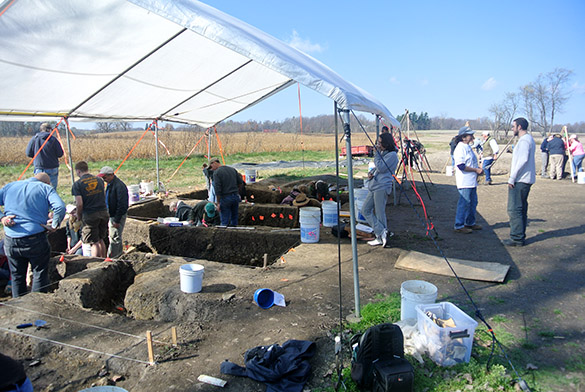 WOOSTER, OHIO–Greg Wiles and I got to experience a bit of field archaeology today at the Cedar Creek Mastodon excavation site. Greg’s Climate change class has visited the site and its associated bog twice this semester: once to do some soil probing and exploration, and then again to extract a core from the bog. This time Greg and I went to consult with the chief archaeologist of the site, Nigel Brush of Ashland University. Nigel wanted our opinions on the stratigraphy of the dig, especially those parts associated with mastodon remains and flint artifacts. The hypothesis the archaeologists are testing is that the mastodon bones and flint blades are part of an ancient butchery site. It was a joy to join our friends on this fantastic Fall day.
WOOSTER, OHIO–Greg Wiles and I got to experience a bit of field archaeology today at the Cedar Creek Mastodon excavation site. Greg’s Climate change class has visited the site and its associated bog twice this semester: once to do some soil probing and exploration, and then again to extract a core from the bog. This time Greg and I went to consult with the chief archaeologist of the site, Nigel Brush of Ashland University. Nigel wanted our opinions on the stratigraphy of the dig, especially those parts associated with mastodon remains and flint artifacts. The hypothesis the archaeologists are testing is that the mastodon bones and flint blades are part of an ancient butchery site. It was a joy to join our friends on this fantastic Fall day.
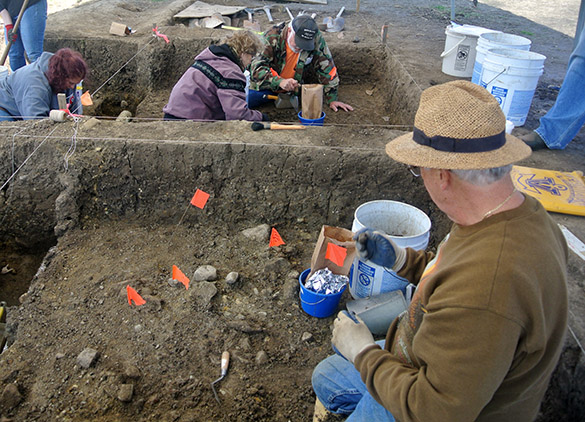 Who doesn’t love an archaeology site? All that enthusiastic hard work with brushes, spades and trowels revealing hidden treasures. Those little orange flags above are tagging bits of mastodon bone that the volunteer excavators have uncovered for mapping and collection. Several schools are represented at this site, and at least a couple dozen citizen scientists.
Who doesn’t love an archaeology site? All that enthusiastic hard work with brushes, spades and trowels revealing hidden treasures. Those little orange flags above are tagging bits of mastodon bone that the volunteer excavators have uncovered for mapping and collection. Several schools are represented at this site, and at least a couple dozen citizen scientists.
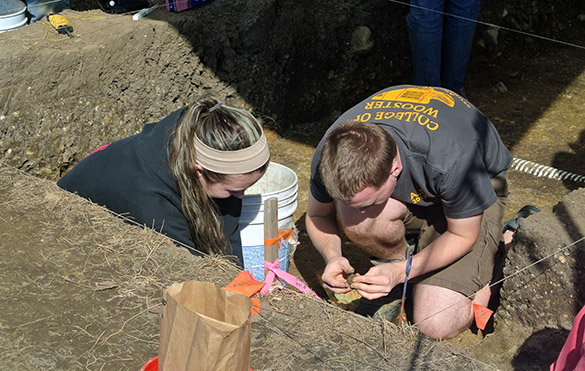 Wooster is represented at the dig by archaeology professor Nick Kardulias, along with two of his students shown above. Hannah Matulek is on the left; Jim Torpy on the right.
Wooster is represented at the dig by archaeology professor Nick Kardulias, along with two of his students shown above. Hannah Matulek is on the left; Jim Torpy on the right.
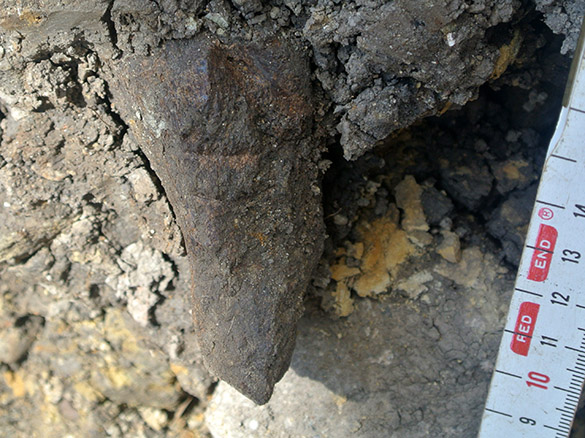 Here is some mastodon bone embedded in one of the excavation walls. The bones are scattered, with some large pieces and many small fragments.
Here is some mastodon bone embedded in one of the excavation walls. The bones are scattered, with some large pieces and many small fragments.
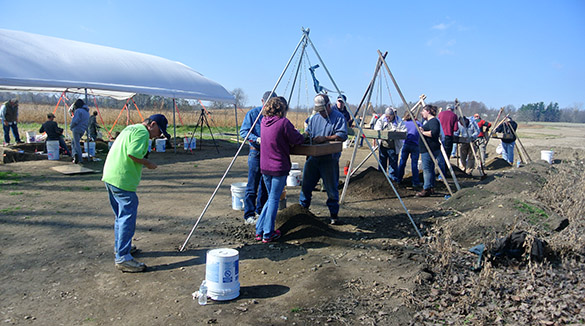 This is the line of sieves for sorting through the excavated sediment. Pleasant enough work today, but I can imagine it’s not so fun in the rain and sleet.
This is the line of sieves for sorting through the excavated sediment. Pleasant enough work today, but I can imagine it’s not so fun in the rain and sleet.
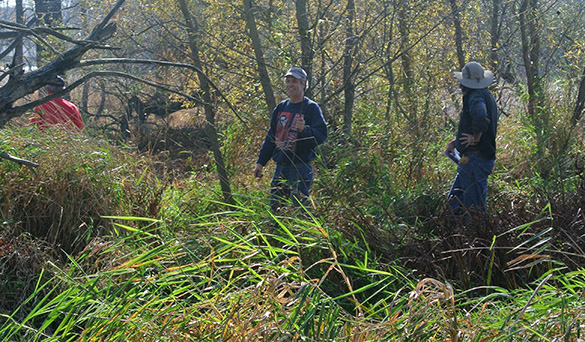 And now for our bit of work. Greg went off into the bog with a soil probe to plan out a new trench to be dug by the landowner. This trench will help correlate the strata in the excavation with what Greg and his students have cored from the bog.
And now for our bit of work. Greg went off into the bog with a soil probe to plan out a new trench to be dug by the landowner. This trench will help correlate the strata in the excavation with what Greg and his students have cored from the bog.
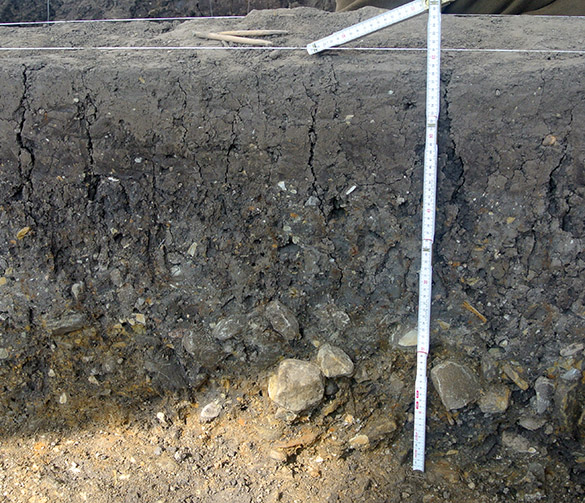 I spent most of my time in the excavations examining the simple layering of the sediments. At the bottom we have a coarse conglomerate with cobble-sized rounded grains. The bones and artifacts lie on top of and among these clasts. Above that unit is a matrix-supported conglomeratic mud with broken rock fragments. At the top is a loam representing the disturbed (plowed) part of the section.
I spent most of my time in the excavations examining the simple layering of the sediments. At the bottom we have a coarse conglomerate with cobble-sized rounded grains. The bones and artifacts lie on top of and among these clasts. Above that unit is a matrix-supported conglomeratic mud with broken rock fragments. At the top is a loam representing the disturbed (plowed) part of the section.
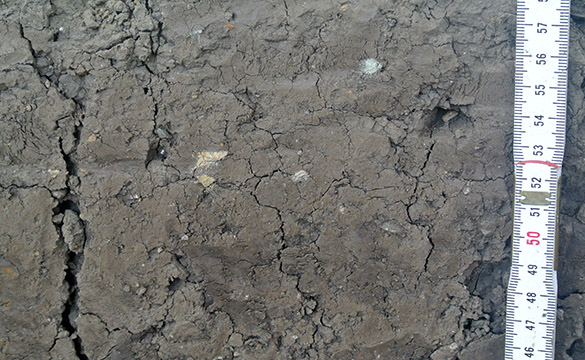 This is a closer view of that middle unit with the “floating” angular rock fragments. My quick assessment (just a suggestion!) is that the coarse gravels beneath are part of a deltaic complex feeding into the bog, which was at the time a marl lake. The mud-with-clasts above it is a debris flow from the surrounding elevations that cascaded down the creek channel and its banks, entombing the bones and artifacts under a slurry of muddy debris. There is scattered charcoal throughout this unit and the top of the cobbles below. Maybe a forest fire denuded the upstream slopes and led to a rain-soaked mudslide? Then again, the charcoal could have come from an ancient barbecue of the mastodon meat.
This is a closer view of that middle unit with the “floating” angular rock fragments. My quick assessment (just a suggestion!) is that the coarse gravels beneath are part of a deltaic complex feeding into the bog, which was at the time a marl lake. The mud-with-clasts above it is a debris flow from the surrounding elevations that cascaded down the creek channel and its banks, entombing the bones and artifacts under a slurry of muddy debris. There is scattered charcoal throughout this unit and the top of the cobbles below. Maybe a forest fire denuded the upstream slopes and led to a rain-soaked mudslide? Then again, the charcoal could have come from an ancient barbecue of the mastodon meat.
In any case, Greg and I had a great time visiting our archaeological colleagues on such a fine day.



Mark, the interpretation as a debris flow makes a lot of sense. I would bet that the upper debris flow is only 200 years old – a legacy of land-clearing and settlement.
Will share this with my class as they did not get a chance to see these exposures. Thanks for posting.
Pingback: Climate Change » Blog Archive » Back to Cedar Creek